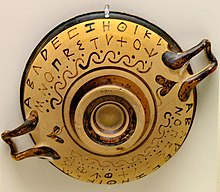
Back Λ Abkhazian Lambda Afrikaans Λ ALS لامدا Arabic Λ ARC Lambda AST Lambda BAR Лямбда Byelorussian Лямбда BE-X-OLD Ламбда Bulgarian
 | ||||||||||||||||||||||||||||||||||||||||||||||||
| Greek alphabet | ||||||||||||||||||||||||||||||||||||||||||||||||
|---|---|---|---|---|---|---|---|---|---|---|---|---|---|---|---|---|---|---|---|---|---|---|---|---|---|---|---|---|---|---|---|---|---|---|---|---|---|---|---|---|---|---|---|---|---|---|---|---|
|
||||||||||||||||||||||||||||||||||||||||||||||||
| History | ||||||||||||||||||||||||||||||||||||||||||||||||
| Use in other languages | ||||||||||||||||||||||||||||||||||||||||||||||||
| Related topics | ||||||||||||||||||||||||||||||||||||||||||||||||
Lambda (/ˈlæmdə/;[1] uppercase Λ, lowercase λ; Greek: λάμ(β)δα, lám(b)da) is the eleventh letter of the Greek alphabet, representing the voiced alveolar lateral approximant IPA: [l]. In the system of Greek numerals, lambda has a value of 30. Lambda is derived from the Phoenician Lamed. Lambda gave rise to the Latin L and the Cyrillic El (Л). The ancient grammarians and dramatists give evidence to the pronunciation as [laːbdaː] (λάβδα) in Classical Greek times.[2] In Modern Greek, the name of the letter, Λάμδα, is pronounced [ˈlam.ða].
In early Greek alphabets, the shape and orientation of lambda varied.[3] Most variants consisted of two straight strokes, one longer than the other, connected at their ends. The angle might be in the upper-left, lower-left ("Western" alphabets) or top ("Eastern" alphabets). Other variants had a vertical line with a horizontal or sloped stroke running to the right. With the general adoption of the Ionic alphabet, Greek settled on an angle at the top; the Romans put the angle at the lower-left.
The HTML 4 character entity references for the Greek capital and small letter lambda are Λ and λ respectively.[4] The Unicode code points for lambda are U+039B and U+03BB.

- ^ "lambda". Oxford English Dictionary (Online ed.). Oxford University Press. (Subscription or participating institution membership required.)
- ^ Herbert Weir Smyth. A Greek Grammar for Colleges. I.1.c
- ^ "Epigraphic Sources for Early Greek Writing". Poinikastas.CSAD.ox.ac.uk. Retrieved 2011-10-03.
- ^ "HTML 4.01 Specification. 24. Character entity references in HTML 4". World Wide Web Consortium.